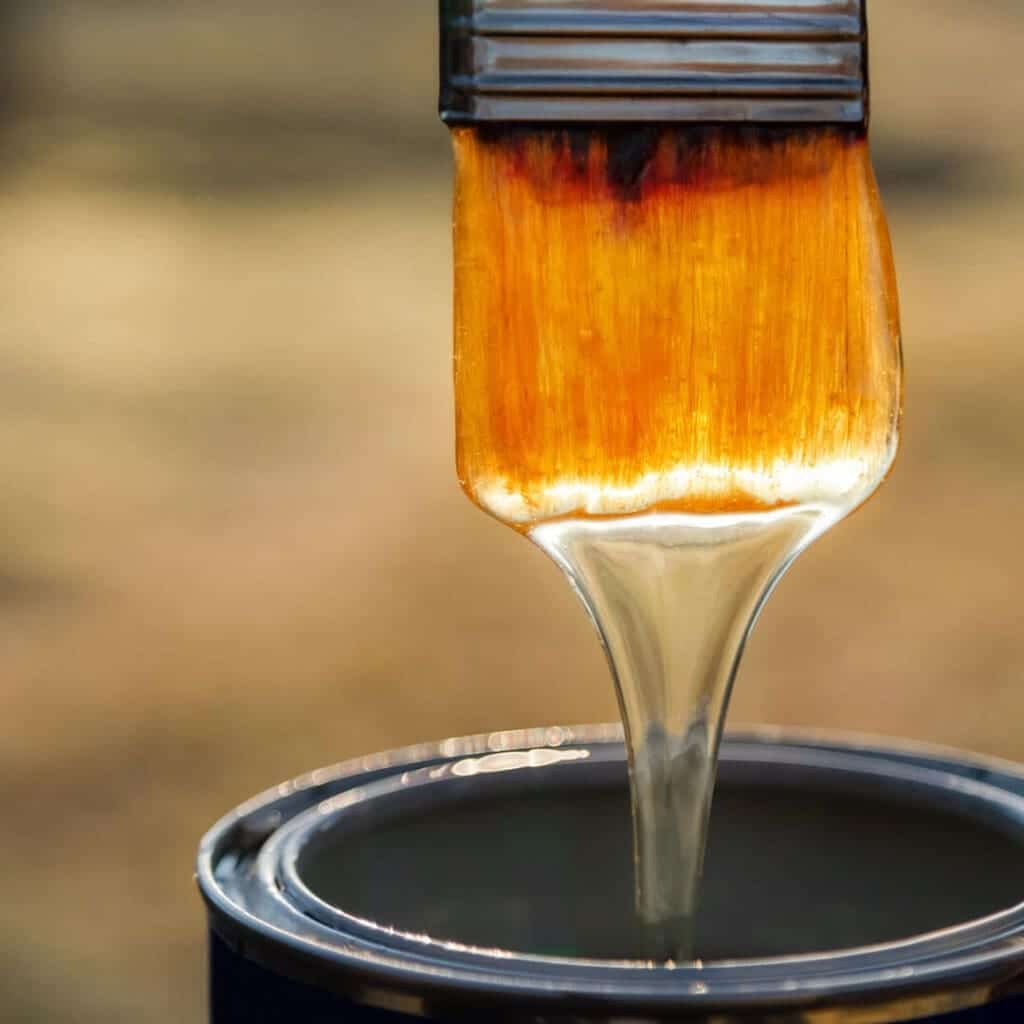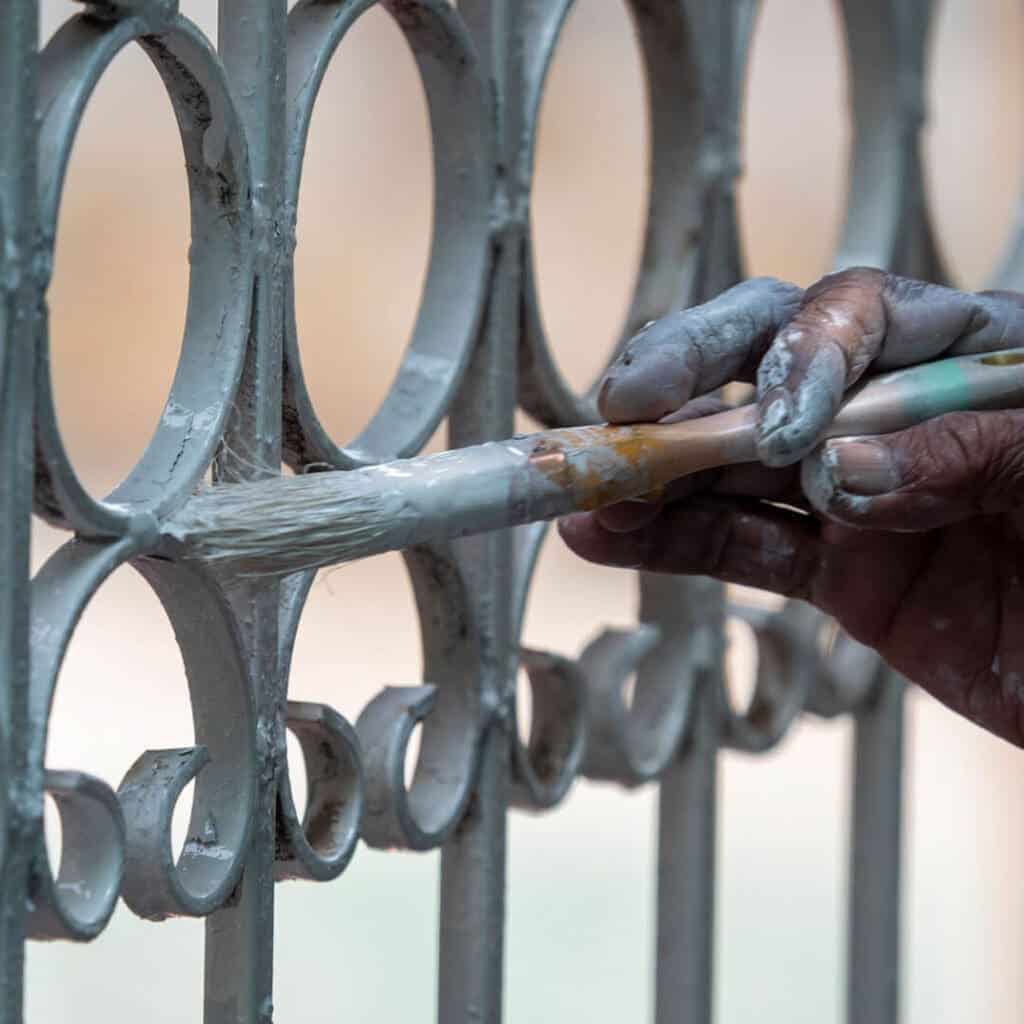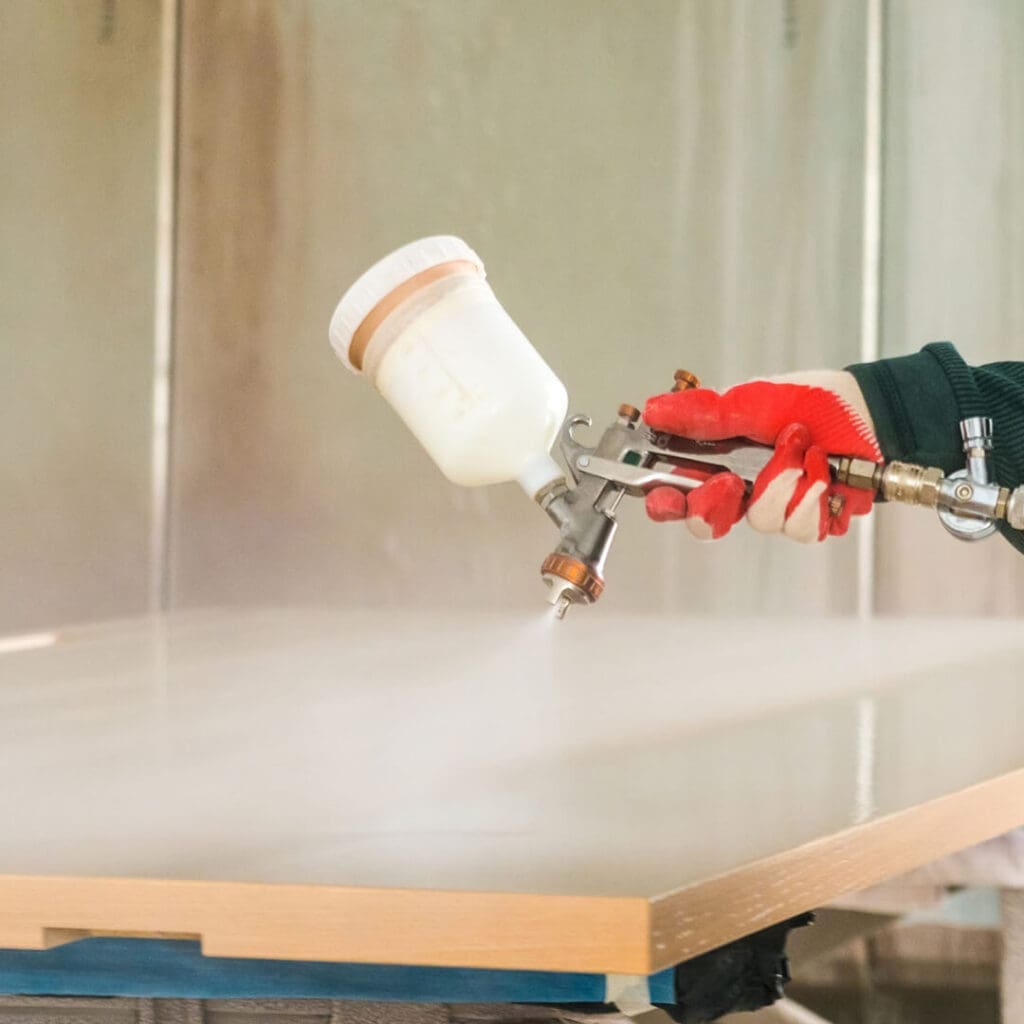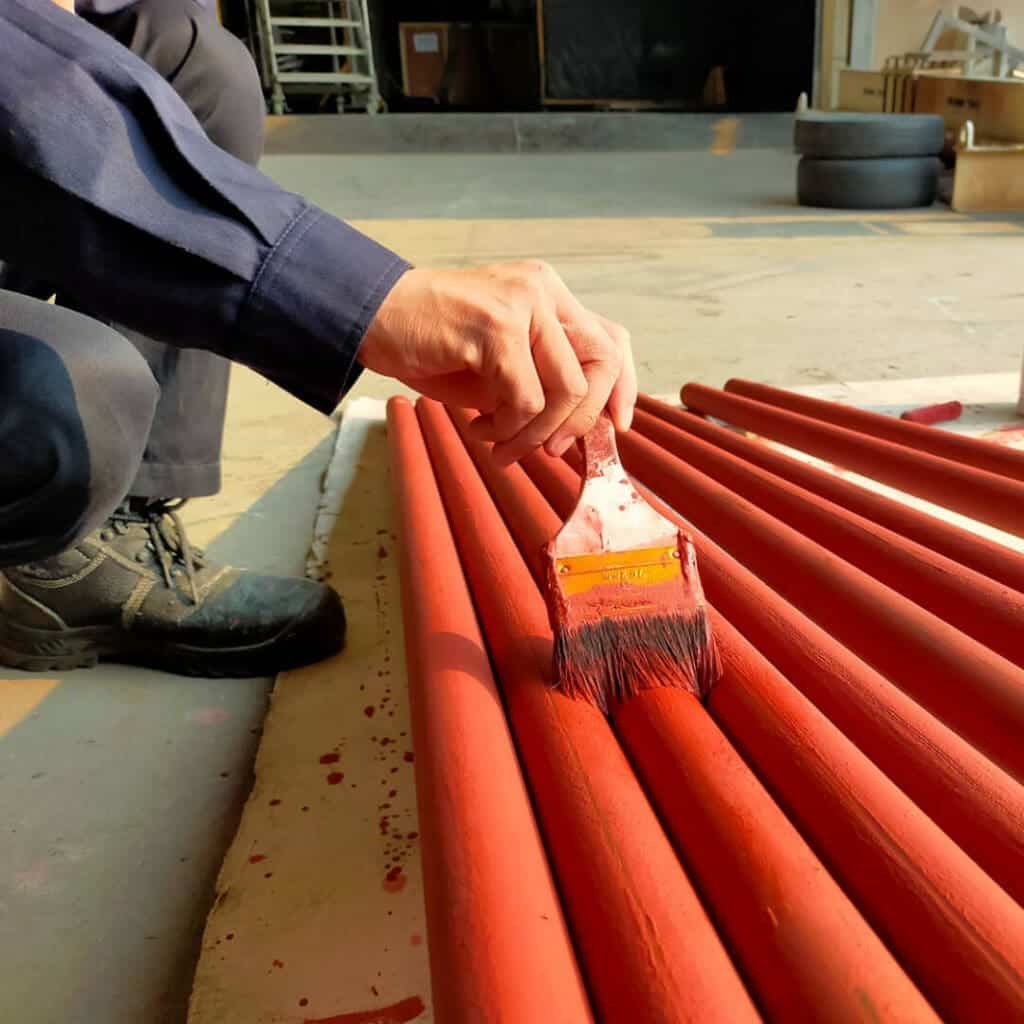Lacquer and enamel are two important finishes for furniture and home decor production. Lacquer and enamel each have pros and cons for the different finishes.
Lacquer and enamel are popular finishes used in various applications, from woodwork and furniture to cars and machinery. While both can provide a glossy finish, they differ in composition, durability, and application. Read on as we explore and define lacquer vs. enamel finish and then explore the pros and cons of these finishes and their differences.
Table of Contents
- What Is Lacquer?
- What Is Enamel?
- Pros And Cons Of Lacquer Paint Finish
- Pros And Cons Of Enamel Paint Finishes
- Differences Between Lacquer And Enamel Finishes
- Frequently Asked Questions About Lacquer and Enamel Paints
- Related Content
What Is Lacquer?
Lacquer is a finish that creates a rugged and durable coating. It is typically made from nitrocellulose dissolved in a solvent, such as lacquer thinner. The mixture is sprayed or brushed onto a surface, and the solvent evaporates, leaving behind a hard, glossy finish.

In Vietnam, we produce a lot of lacquer items. In Vietnam, we do a lovely lacquer finish that is the same as the ancient Vietnamese lacquer technique.
The lacquer we produce in Vietnam is the traditional Vietnamese lacquer that is built upon layer upon layer of surface treatment and clay. You can contact us to learn more about our lacquer paint and why Vietnamese lacquer is an excellent surface treatment.
What Is Enamel?
Enamel is a type of paint that creates a stiff and glossy finish. It is typically made from resin, pigments, and solvents.

Enamel can be oil-based or water-based, and it can be applied by brush, roller, or spray gun. For some types of products, we also use enamel paint.
Pros And Cons Of Lacquer Paint Finish
The lacquer paint finish is popular for those seeking a high-gloss, rugged, and durable coating. It has been used for centuries to provide a smooth, mirror-like finish on everything from furniture to cars.

Unlike many other finishes, lacquer has pros and cons, which must be considered before deciding whether it is the right choice for a particular application.
Pros Of Lacquer Finishes
- Dries Quickly – Lacquer dries faster than enamel, allowing multiple coats to be applied in a shorter period.
- High Gloss – Lacquer provides a glossy finish that is hard to beat. It gives a mirror-like shine that is perfect for car finishes or furniture.
- Easy Application – Lacquer can be applied by spray gun or brush, making it easy for DIYers to use.
- Easy Repair – Lacquer can be easily repaired by sanding and reapplying a new coat of lacquer, making it perfect for furniture and other wooden surfaces.
- Versatile – Lacquer can be used on various surfaces, including wood, metal, and plastic.
- Chemical Resistance – Lacquer is resistant to chemicals and solvents, making it ideal for industrial applications.
- UV Resistance – Lacquer is resistant to UV radiation, which makes it an excellent choice for outdoor applications.
- Non-yellowing – Lacquer will not yellow over time, unlike some other finishes.
- Can Be Tinted – Lacquer can be tinted to create a variety of colors and effects.
- Smooth Finish – Lacquer creates a smooth finish free from brush strokes or roller marks.
Cons Of Lacquer Finishes
- Flammable – Lacquer is highly flammable, so it must be handled with care.
- Toxic – Lacquer fumes are toxic, so proper ventilation is required.
- Not Durable – Lacquer is less durable than other finishes, such as polyurethane or epoxy.
- Not Scratch-resistant – Lacquer is prone to scratching, so it may not be the best choice for high-traffic areas. But it does work well on furniture and home decor items.
- Limited Temperature Range – Lacquer can only be used between 60°F and 90°F.
- Not water-resistant – Some lacquer is not water-resistant. Some Vietnamese lacquer that is produced with water is considered to be water-resistant.
- Difficult To Remove – Lacquer is challenging to remove once applied, requiring sanding or chemical strippers.
- Yellowing With Age – Although lacquer does not turn yellow over time, it can be yellow if exposed to high heat or direct sunlight. That is why we do not recommend putting lacquer furniture away from the sun or near a window with very heavy direct sunlight.
- Peeling – Lacquer can peel if it is applied too thickly or if it is exposed to moisture. That is why you need to work with manufacturers who understand what they are doing. We know how to apply lacquer to production so it will not peel carefully.
- Not Eco-friendly – Lacquer that is not a natural lacquer can contain harmful chemicals and is not considered an eco-friendly option when applying lacquer.
Pros And Cons Of Enamel Paint Finishes
The enamel paint finish is a popular option for those looking for a stiff and glossy coating that is more durable than other finishes. It is commonly used in various applications, including metalwork, woodwork, and automotive finishes.

However, like any other finish, enamel paint has pros and cons to consider before deciding whether it is the right choice for a particular project.
Pros Of Enamel Finishes
- Durable – Enamel is more durable than lacquer, making it ideal for high-traffic areas.
- Non-toxic – Water-based enamel is non-toxic and environmentally friendly, but regular enamel paint is not and is a toxic paint.
- Scratch-resistant – Enamel is more scratch-resistant than lacquer, making it ideal for surfaces subjected to wear and tear.
- Wide range of finishes – Enamel is available in various finishes, from high-gloss to matte, giving it versatility.
- It can be applied to various surfaces – Enamel can be applied to wood, metal, and plastic surfaces, making it a versatile option.
- Can be used in a range of temperatures – Enamel can be used in temperatures between 50°F and 90°F, making it a good choice for outdoor applications.
- Water-resistant – Enamel is water-resistant, making it ideal for moist surfaces.
- Good adhesion – Enamel has good properties, allowing it to stick to surfaces well.
- Chemical Resistance – Enamel is resistant to chemicals and solvents, making it ideal for industrial applications.
- Can be easily cleaned – Enamel can be easily cleaned with soap and water, making it a low-maintenance option.
Cons Of Enamel Finishes
- Long drying time – Enamel takes longer than lacquer, which can disadvantage specific applications.
- Difficult to apply – Enamel can be challenging to apply evenly and may require multiple coats for a smooth finish.
- Yellowing with age – Some types of enamel can turn yellow over time, particularly when exposed to UV light.
- Limited color range – Enamel is available in a limited range of colors, which may limit its use in specific applications.
- Not as glossy – Enamel does not provide the same high-gloss finish as lacquer.
- Odor – Enamel has a strong odor, which can be unpleasant for some users.
- Difficult to remove – Enamel is challenging to remove once applied, requiring sanding or chemical strippers.
- Not As Versatile – Enamel is not as versatile as lacquer in its application and is not recommended for use on certain surfaces.
- Not as smooth – Enamel can sometimes leave brush strokes or roller marks, making it difficult to achieve a smooth finish.
- Prone to cracking – Enamel can be prone to cracking if applied too thickly or if the surface is not prepared correctly.
Differences Between Lacquer And Enamel Finishes
While lacquer and enamel finishes provide a stiff and glossy coating, they differ. The primary differences are in their composition, durability, and application.
Lacquer is made from nitrocellulose dissolved in a solvent, while enamel is made from a mixture of resin, pigments, and solvents. Enamel is more durable than lacquer, making it better suited for high-traffic areas.
Lacquer dries faster than enamel, allowing multiple coats to be applied in a shorter period.
Enamel is water-resistant, while most lacquer is not. Enamel is available in various finishes, while lacquer typically provides a high-gloss or semi-gloss finish.
Lacquer is more versatile in its application, but enamel is easier to clean and more environmentally friendly.
Lacquer and enamel finishes have pros and cons, and the choice will depend on the specific application. Ultimately, the choice between lacquer and enamel comes down to personal preference and the specific needs of the project at hand.
At Mondoro, we would love to help you decide which finish would be best for manufacturing your home decor and furniture product.
Find out more about how Mondoro can help you create, develop, and manufacture excellent home decor and home furniture products – including lacquer furniture. Don’t hesitate to contact me, Anita. Check out my email by clicking here or become a part of our community and join our newsletter by clicking here.
Mondoro gives out a FREE Lookbook to anyone interested. You can receive a copy of our latest Lookbook by clicking here.
Listen to our Podcast called Global Trade Gal. You can find it on all major podcast platforms. Try out listening to one of our podcasts by clicking here.
Subscribe to our Mondoro Company Limited YouTube Channel filled with great videos and information by clicking here.
Frequently Asked Questions About Lacquer and Enamel Paints
Can enamel paint be used on wood surfaces?
Yes, enamel paint can be used on wood surfaces. However, it is essential to ensure the wood is correctly prepared before applying the paint to ensure good adhesion.
Can lacquer paint be used on metal surfaces?
Yes, lacquer paint can be used on metal surfaces. It provides a rugged and durable coating resistant to chemicals and solvents.
How do you apply lacquer paint?
Lacquer paint can be applied with a brush, spray gun, or aerosol can. Ensuring the surface is clean and dry before applying the paint is essential.
What is the difference between water-based and oil-based enamel paint?
Water-based enamel paint is non-toxic and environmentally friendly, while oil-based enamel paint is more durable and provides a smoother finish.
How long does it take for lacquer paint to dry?
Lacquer paint dries quickly, typically within 15-30 minutes, depending on the temperature and humidity.
Can enamel paint be used on plastic surfaces?
Yes, enamel paint can be used on plastic surfaces. However, it is essential to ensure the plastic is correctly prepared before applying the paint to ensure good adhesion.
How do you remove enamel paint?
Enamel paint can be removed using paint strippers or by sanding the surface.
Can you paint over the lacquer with enamel?
Yes, you can paint over lacquer with enamel. However, ensuring that the lacquer is adequately sanded and cleaned before applying the enamel paint is essential.
What is the difference between lacquer thinner and paint thinner?
Lacquer thinner is specifically designed to thin lacquer paint, while paint thinner is used for various thin types of paint, including enamel.
What is Vietnamese Lacquer?
Vietnamese lacquer is a traditional technique produced in Vietnam for over 800 years. This lacquer is built layer upon layer with many different layers from preparing the surface and lacquer paints.
Related Content
Can I Put A Clearcoat On Top Of The Lacquer Paint?
We spray a PU topcoat on top of our lacquer products. But to correctly spray the PU top coat, you need first to make sure the lacquer is completely dry, then spray a light PU clear coat on top of the paint. We sand in between each coat to ensure no issues with the topcoat layers.
You can discover more by reading Can I Put A Clearcoat On Top Of Lacquer Paint? by clicking here.
Where Did Lacquerware Originate? An Interesting History
Lacquerware originated from China; some lacquerware has come from 10,000 BC. The Chinese brought the lacquerware technique to many other parts of Asia, particularly Japan, and Vietnam. Each country has developed its lacquerware techniques, colors, and shapes.
You can discover more by reading Where Did Lacquerware Originate? An Interesting History by clicking here.
How To Manufacture Vietnamese Lacquerware?
Vietnamese lacquer requires many manufacturing steps in the lacquer production process, including making the base, preparing the lacquer base to be applied, and finally, using the lacquer paint on the surface. Every piece must be carefully sanded to give it a very smooth surface. Vietnamese lacquerware production requires a lot of skill and knowledge.
To learn more, you can read How to Manufacture Vietnamese Lacquerware? An Insider’s Guide to Lacquer by clicking here.

